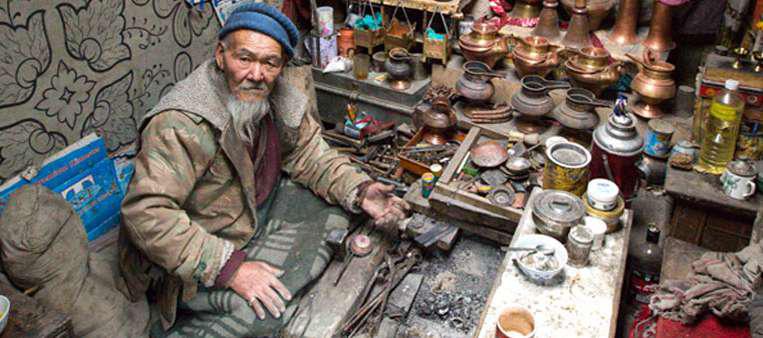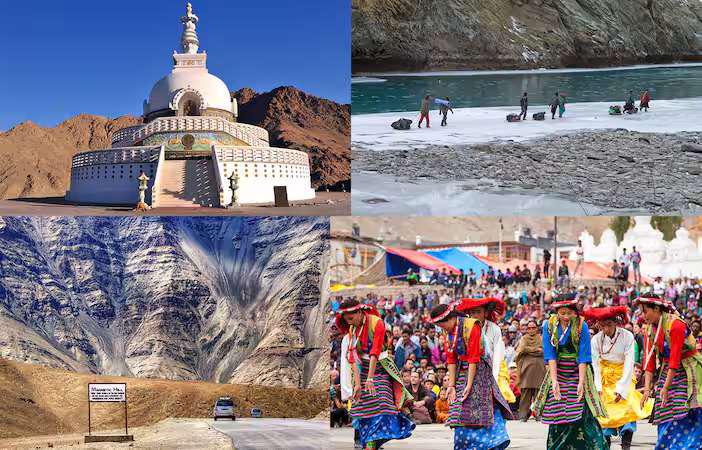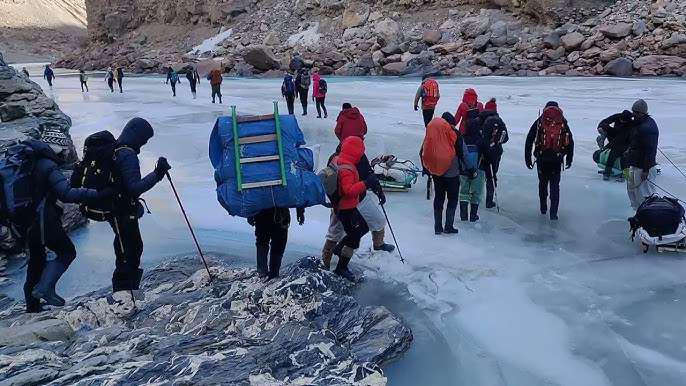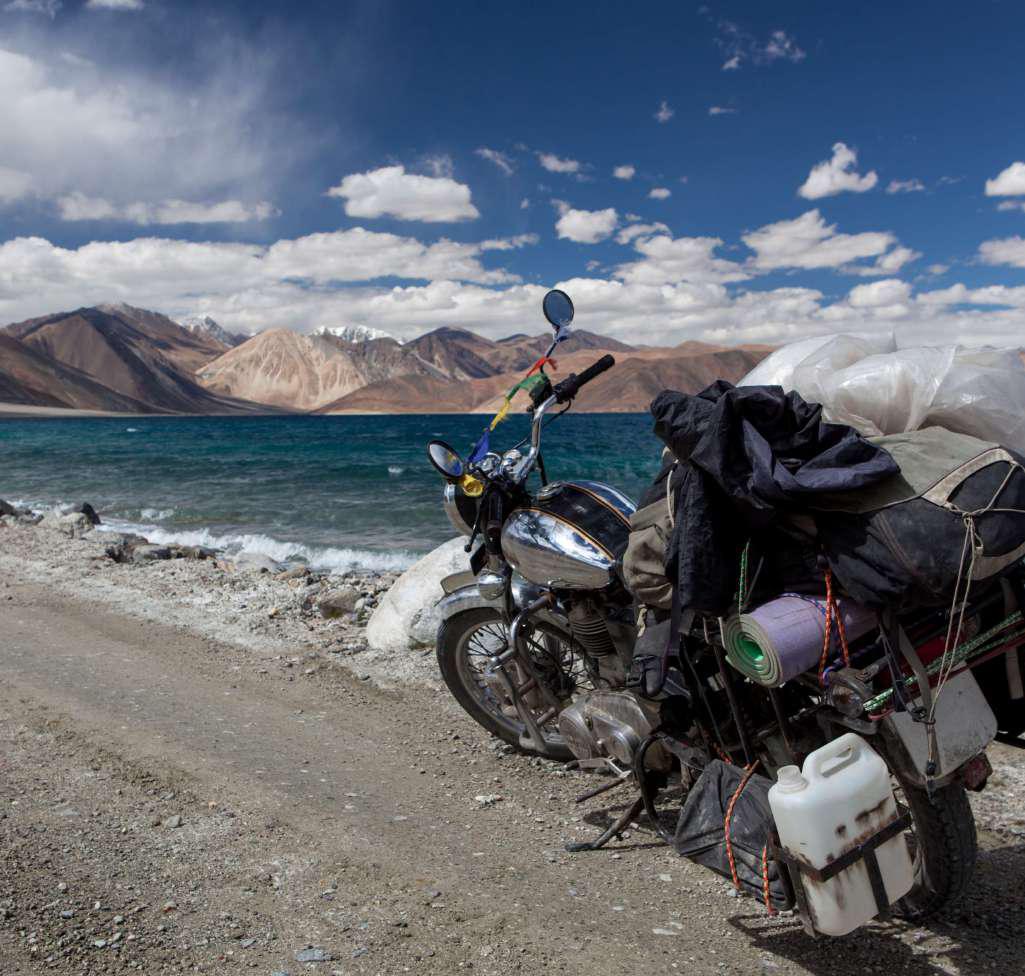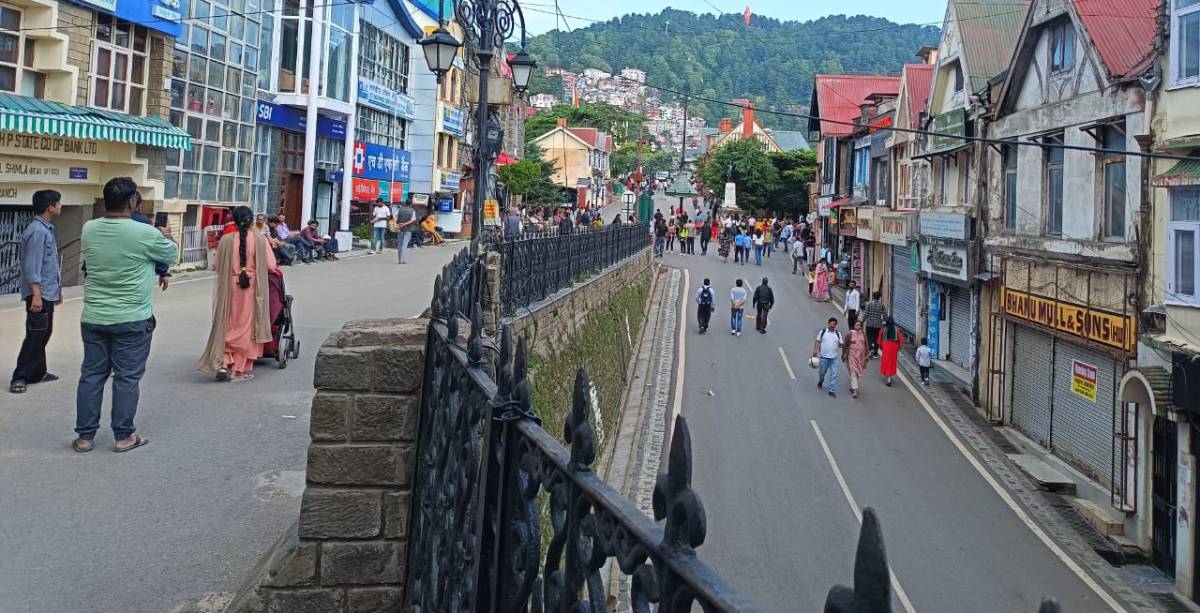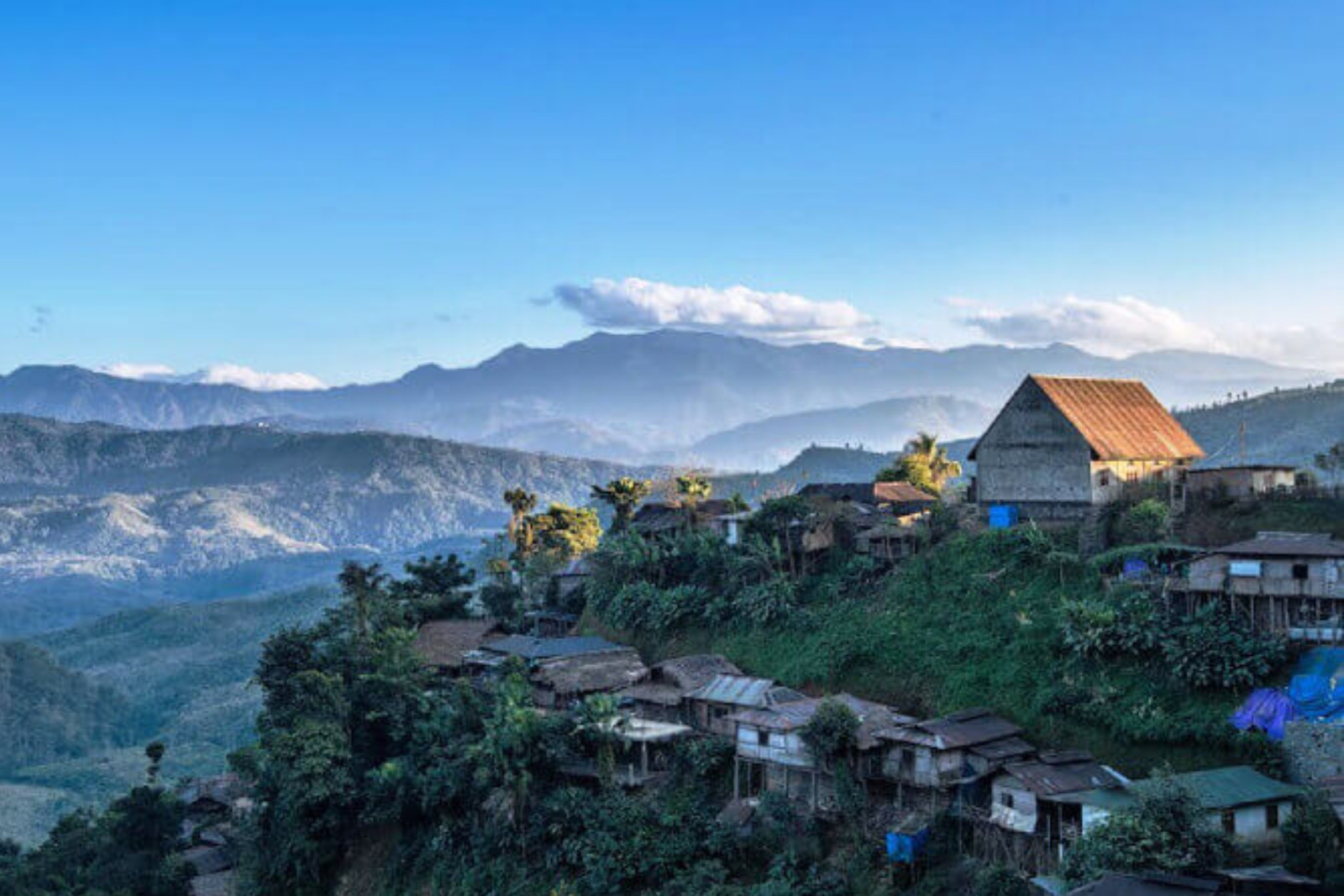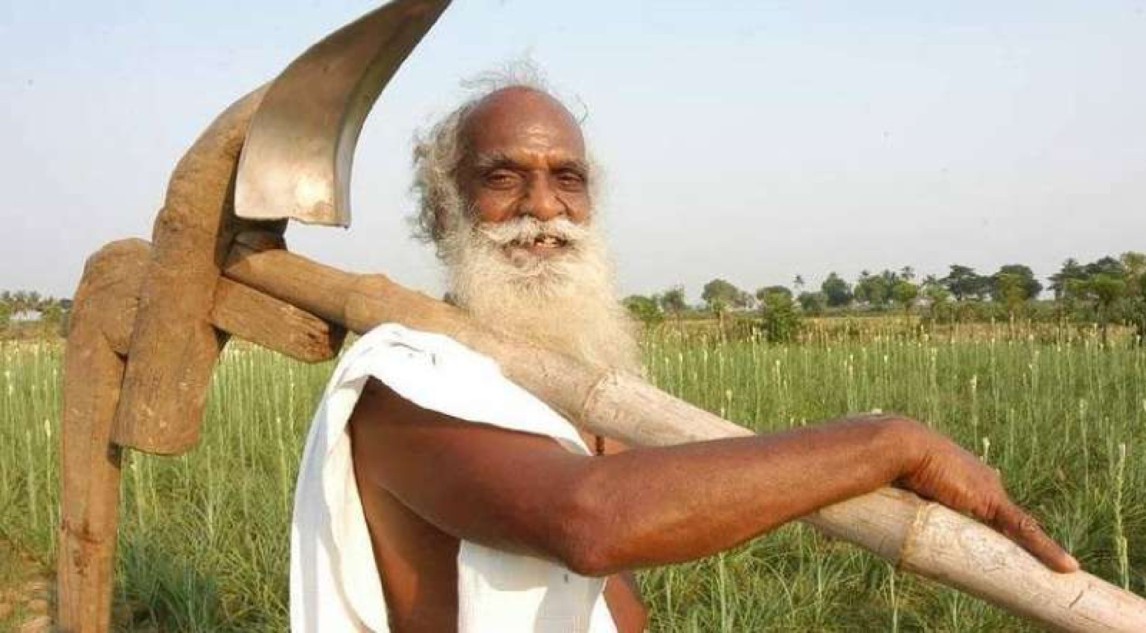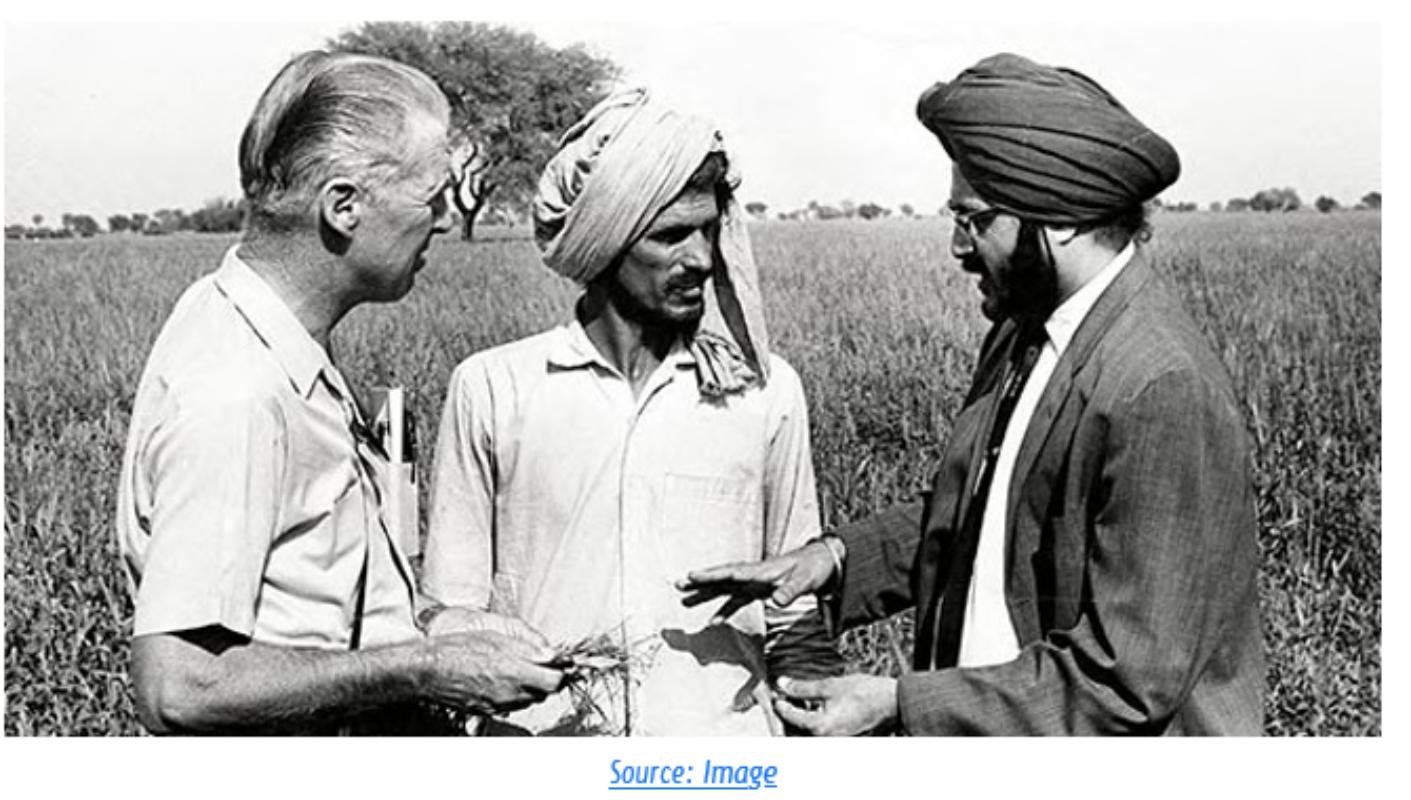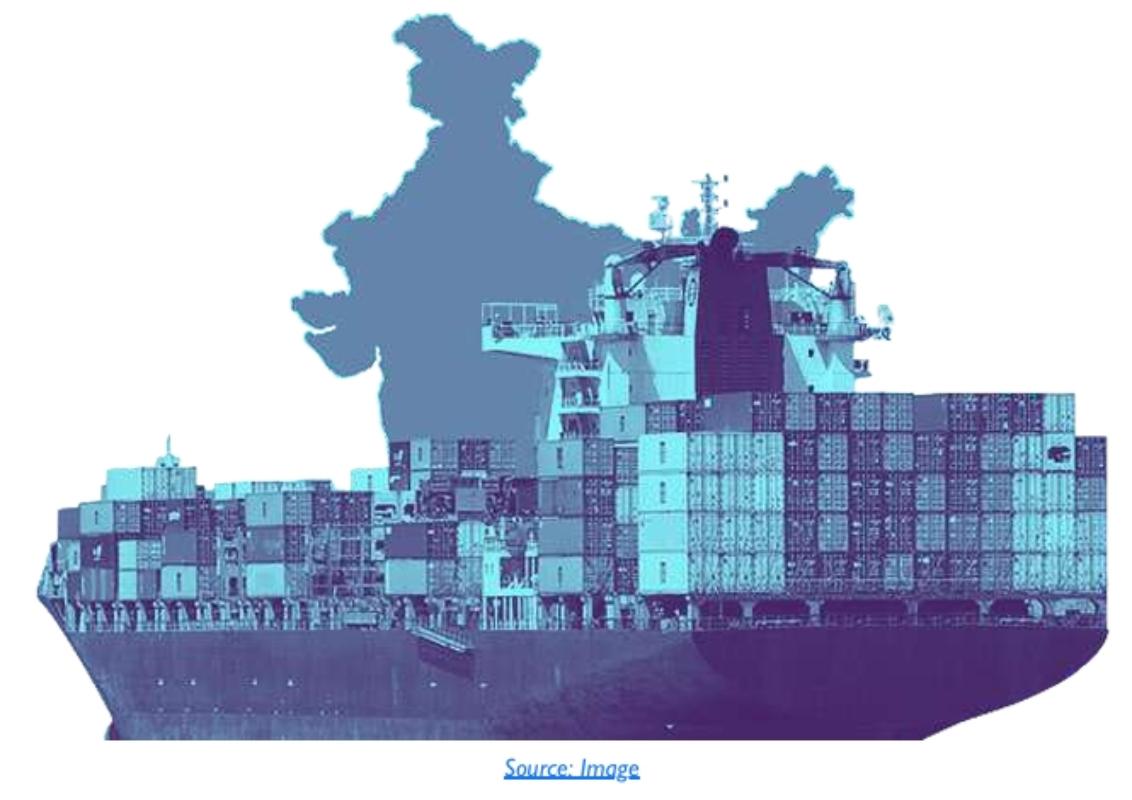Purpose and scope of the study
The study aims to systematically evaluate the potential and challenges associated with youth employment and entrepreneurship in Ladakh’s tourism sector. By examining the current employment landscape, identifying entrepreneurial opportunities, analyzing skill gaps, and recommending strategic interventions, this report provides a comprehensive understanding of how youth can drive and benefit from the region’s tourism growth.
Youth entrepreneurship in Ladakh’s tourism sector is crucial for the region’s economic development. Young entrepreneurs stimulate local economies, create jobs, and promote sustainable tourism practices. Dispersing tourism benefits throughout Ladakh, even remote areas can experience economic upliftment.
However, the region faces challenges such as limited infrastructure, road connectivity, telecommunications, medical services, and emergency facilities. Addressing these issues through targeted sustainable development plans, quality homestay development, waste management systems, and skill training programs is essential. Supporting young entrepreneurs with these resources and strategies will unlock the full potential of Ladakh’s tourism sector, driving significant economic growth and social prosperity.
This report investigates youth employment and entrepreneurial opportunities within Ladakh’s tourism sector. It aims to:
- Assess the Current Employment Landscape: Examining existing employment opportunities and skill requirements within Ladakh’s tourism sector, including understanding current job roles, demand-supply dynamics, and workforce distribution.
- Identify Entrepreneurial Opportunities: Exploring and categorizing potential business opportunities for youth in tourism-related ventures, identifying emerging trends, business models, and market needs.
- Analyze Skill Gaps and Training Needs: Providing a detailed analysis of skill gaps and training requirements necessary to boost youth employability and entrepreneurial capabilities, proposing targeted training programs and educational initiatives.
- Recommend Strategic Interventions: Developing actionable recommendations for policymakers, training institutions, and industry stakeholders to promote sustainable employment and entrepreneurial growth, enhancing the overall impact of youth in Ladakh’s tourism sector.
Introduction to Ladakh
Ladakh, a remote region in the northern Indian Himalayas, is distinguished by its dramatic landscapes and distinct cultural heritage. The region, situated between the Karakoram and Himalaya mountain ranges, includes the districts of Leh and Kargil. It is renowned for its high-altitude deserts, snow-capped peaks, and pristine lakes, drawing numerous visitors for adventure tourism, spiritual retreats, and cultural experiences.
Geography and Demographics
Ladakh, a Union Territory (UT) in India, spans an area of approximately 59,146 square kilometers. The region is known for its rugged terrain, with an overall population of around 274,289 as per the 2011 Census . Ladakh is home to some of the highest peaks in the world, including Saltoro Kangri, which stands at 7,742 meters. The average elevation of the region is about 3,500 meters, contributing to its unique climatic and environmental conditions.
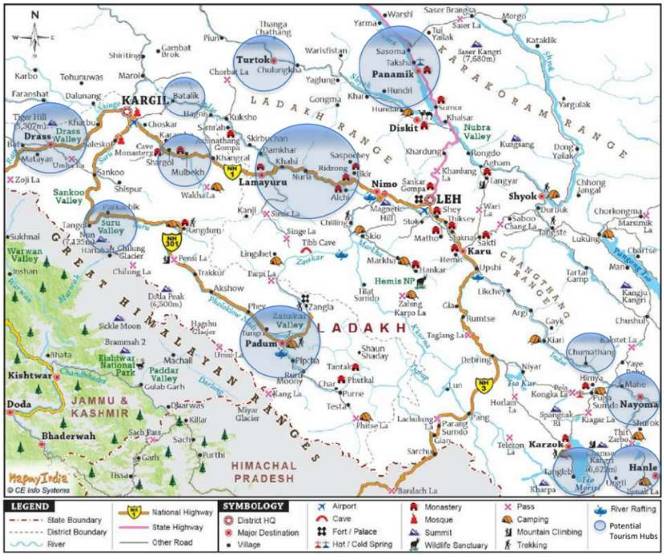
Leh District
Leh Town and Surrounding Areas: Connectivity: Connected via National Highway 1 to Srinagar and via Leh-Manali Highway to Manali. These roads are only open from May to November, but local roads remain open year-round. Leh airport has flights to Delhi, Srinagar, Jammu, and Mumbai. Demographics: The population decreases by 15-20% from summer to winter as residents move to warmer areas. Tourism Concentration: Nearly 70% of tourists are concentrated in four wards—Changspa, Tukcha, Shenam, and Leh main market. Development Needs: Improved roads, tourist signages, facilitation centers, and solid waste management systems.
Nubra Valley (Diskit, Hunder, Turtuk): Tourism Development: Diskit and Hunder are well-developed with campsites, hotels, and guesthouses, known for sand dunes and Bactrian camels. Turtuk, with its cultural and natural attractions, needs further infrastructure development. Potential: The area between Hunder and Turtuk has significant potential for eco-tourism, adventure tourism, heritage tourism, and rural tourism.
Saspol and Alchi: Tourism Activities: Known for Buddhist caves, monasteries, trekking, and river rafting. Promotion of homestays and adventure activities is needed.
Panamik: Unique Attractions: Famous for its hot springs and proximity to the Indo-Tibetan border. The area is overcrowded with tourists, and additional tourist infrastructure is required.
Chumathang and Nyoma Belt: Eco and Wellness Tourism: Known for hot sulfur springs and peaceful environments. Requires more tourist accommodations, restaurants, and eco-tour packages.
Hanle: Astro-Tourism: Home to the Indian Astronomical Observatory, the highest in the world. Promoting community-based astro-tourism and nomadic experiences can enhance tourism.
Kargil District
Kargil Town: Historical Significance: Historically a trade center, now attracting tourists for its unique landscape, heritage sites, and adventure tourism potential.
Drass: Winter Sports and Patriotic Tourism: Potential for winter sports, eco-tourism, and patriotic tourism. Requires homestays, hotels, and ski resorts.
Zanskar: Adventure and Buddhist Tourism: Known for monasteries and adventure sports like skiing and trekking. Requires development of tourism units, wayside amenities, and road connectivity.
Batalik, Aryan Valley: Cultural and Eco-Tourism: Known for unique cultural traditions and festivals. Development of tourism and homestay infrastructure is needed.
Mulbekh Wakah Cluster: Skiing and Buddhist Sites: Ideal for skiing infrastructure and promoting Buddhist sites. Homestays should be the focus over large hotels.
Demographic Overview
| Sub-district | Population (2011) | Population Growth (2001-11) | Area (sq km) | Population Density (persons per sq km) |
|---|---|---|---|---|
| Kargil | 86,461 | 13.87% | 14,036 | 4.63 |
| Drass | 15,295 | 18.02% | 3,452 | 4.43 |
| Sankoo | 12,486 | 12.50% | 1,258 | 9.93 |
| Shakar-Chiktan | 10,832 | 10.30% | 987 | 10.98 |
| Taisuru | 14,737 | 15.20% | 786 | 18.75 |
| Zanskar | 13,687 | 11.80% | 654 | 20.92 |
| Leh | 93,961 | 20.45% | 45,110 | 0.68 |
| Nubra | 15,689 | 18.50% | 7,830 | 2 |
| Durbuk | 9,906 | 14.10% | 6,570 | 1.51 |
| Khalatse | 8,046 | 16.70% | 3,480 | 2.31 |
| Kharu | 6,397 | 19.20% | 2,650 | 2.41 |
| Saspol | 6,589 | 17.30% | 1,980 | 3.33 |
Economic Overview
Ladakh’s economy is diverse, with significant contributions from tourism, agriculture, trade, local crafts, and emerging industries. This overview provides a detailed analysis of each sector, highlighting their contributions to the region’s GDP, challenges, and opportunities for youth engagement. As of the latest available data, Ladakh’s per capita income stands at ₹1,85,000 (approximately USD 2,240) for the year 2021-22.
Key Economic Sectors
Tourism Tourism is the cornerstone of Ladakh’s economy, contributing approximately 50% to the region’s GDP.
- Economic Contribution: Tourism accounts for a substantial portion of the region’s GDP, estimated at around 50%.
- Employment: Engages a significant portion of the youth in various roles including tour guides, hospitality, and adventure sports.
- Tourist Arrivals: Ladakh attracts hundreds of thousands of visitors annually, with a notable increase in both domestic and international tourists over the past decade.

Agriculture
Agriculture in Ladakh, while limited due to the harsh climate, contributes around 15% to the region’s GDP.
- Land Holdings: Average land holdings range from 0.5 to 2 hectares per household.
- Crops: Primarily includes barley, wheat, and vegetables. Horticulture, such as apricots and apples, provides additional income.
- Livestock: Sheep, yak, and dairy farming are significant, providing wool, milk, and meat.
Challenges: The harsh climate and limited growing season constrain productivity.
Trade and Local Crafts
Trade and local crafts contribute around 10% to Ladakh’s GDP, playing a vital role in the local economy.
- Trade: Historically centered in Kargil, cross-border trade with regions like Central Asia, China, and Pakistan has been significant, particularly in goods like wool, carpets, and textiles.
- Local Crafts: Handicrafts, including traditional textiles, thangka paintings, and metalwork, are important for local livelihoods. These crafts are often sold to tourists, adding to the regional economy.
Emerging Industries
Emerging industries, including renewable energy and digital employment, are beginning to shape Ladakh’s economic landscape.
- Renewable Energy: With its abundant sunlight, Ladakh has significant potential for solar energy projects. Major projects include solar power plants and initiatives to harness wind energy.
- Digital Employment: There is a growing interest in digital jobs and remote work opportunities, particularly among the youth.
- Youth Entrepreneurship: Youth entrepreneurship in Ladakh has seen a steady increase over the past five years, with many young people starting businesses in tourism, crafts, and digital sectors. The number of young entrepreneurs has increased by approximately 20% over the past five years. Various government and non-governmental programs support youth entrepreneurship through training, funding, and mentorship.
Tourism Sector Overview
The tourism sector is a cornerstone of Ladakh’s economy, drawing significant numbers of visitors each year to its unique landscapes and cultural heritage. The sector has seen substantial growth, contributing notably to local livelihoods and infrastructure development. Managing this growth sustainably and addressing challenges related to infrastructure and seasonality are critical for future success.
Ladakh’s tourism industry primarily focuses on adventure tourism, cultural tourism, and eco-tourism. The region attracts tourists for its high-altitude treks, Buddhist monasteries, and scenic beauty. Key zones within Ladakh have varying levels of tourism infrastructure, including guesthouses, hotels, and homestays.
| Zone | Number of Registered Guesthouses | Number of Rooms | Annual Tourist Influx | Seasonal Variability | Key Attractions |
|---|---|---|---|---|---|
| Leh District | 150 | 3,000 | 300,000 | High in summer, low in winter | Leh Palace, Shanti Stupa, Pangong Lake, Nubra Valley |
| Nubra Valley | 50 | 800 | 50,000 | Moderate seasonal impact | Sand Dunes, Bactrian Camels, Hunder, Diskit Monastery |
| Zanskar Region | 30 | 500 | 30,000 | Very low in winter | Zanskar Monasteries, Padum, Stongdey Monastery |
| Kargil District | 40 | 600 | 20,000 | Low in winter | Kargil War Memorial, Drass, Suru Valley |
| Changthang Region | 10 | 200 | 10,000 | Extremely low in winter | Hanle Observatory, Nomadic Experiences |
1. Leh District:
- Tourist Hub: The central hub of tourism activity in Ladakh, Leh sees the highest number of tourists, concentrated in its main market and surrounding areas.
- Infrastructure: Guesthouses and hotels are often fully booked during the peak summer months. Efforts to improve infrastructure, including better signage and waste management, are essential to accommodate the growing number of visitors.
- Key Attractions: Leh Palace, Shanti Stupa, and Pangong Lake are major attractions.
2. Nubra Valley:
- Unique Landscape: Known for its unique desert landscape and cultural sites, Nubra attracts a moderate number of tourists.
- Development Potential: Significant development has occurred, but there remains potential for further growth in eco-tourism and adventure tourism, particularly in areas like Turtuk and Hunder.
- Key Attractions: Sand Dunes, Bactrian Camels, and Diskit Monastery are popular with visitors.
3. Zanskar Region:
- Cultural Heritage: Despite its rich cultural heritage and natural beauty, Zanskar remains less developed in terms of tourism infrastructure.
- Seasonal Challenges: Harsh winter conditions limit tourist activity, but with improved accessibility and infrastructure, the region has the potential to become a major destination for adventure and cultural tourism.
- Key Attractions: Zanskar Monasteries and Padum are key attractions.
4. Kargil District:
- Historical Significance: Kargil, with its historical significance and scenic landscapes, attracts a smaller number of tourists compared to Leh.
- Enhancement Opportunities: Improving air connectivity and developing rural tourism destinations can enhance Kargil’s tourism appeal.
- Key Attractions: Kargil War Memorial and Drass are noteworthy sites.
5. Changthang Region:
- Remote Beauty: Home to high-altitude attractions like the Hanle Observatory, Changthang is less frequented by tourists due to its remote location and extreme weather conditions.
- Potential Development: Promoting community-based tourism and developing infrastructure could boost tourism in this region.
- Key Attractions: Hanle Observatory and nomadic experiences are unique offerings.
Tourism contributes approximately 50% to Ladakh’s GDP, highlighting its critical role in the regional economy. It engages a significant portion of the population, particularly the youth, in various roles such as tour guides, hospitality workers, and adventure sports operators. Efforts are needed to ensure sustainable tourism practices to preserve the natural and cultural heritage of Ladakh while accommodating increasing tourist numbers.
The tourism industry in Ladakh is largely managed by tour operators from major Indian cities such as Delhi, Pune, and Bangalore. These operators organize comprehensive travel packages while employing local residents primarily on a daily wage basis. This model provides immediate job opportunities but often limits long-term economic benefits for the local community.
 Employment Opportunities
Employment Opportunities
Tourism has created diverse employment opportunities for local youth, engaging approximately 8,000 to 10,000 individuals in various activities:
| Activity | Estimated Number of Employed Youths |
|---|---|
| Guesthouses and Homestays Management | 2,000 – 3,000 |
| Local Tour Operators | 1,500 – 2,000 |
| Adventure Tourism (Guides, Support Staff) | 2,500 – 3,000 |
| Backup Staff and Drivers | 500 – 700 |
| Winter Sports and Activities | 500 – 800 |
| Other Support Roles (Admin, Customer Service) | 300 – 500 |
- Homestays and Boutique Hotels: Young entrepreneurs are establishing homestays and boutique hotels, leveraging Ladakh’s cultural and natural appeal to offer personalized services.
- Adventure Tour Companies: New businesses focus on adventure tourism activities such as trekking, rafting, and mountaineering.
- Crafts and Organic Products: Businesses providing crafts, organic products, and traditional cuisine are gaining popularity among tourists.
- Eco-Tourism: Emphasis on sustainable practices and eco-friendly accommodations is growing.
- Adventure Sports: Expansion in activities like trekking, rafting, and mountaineering.
- Spiritual Tours: Increasing interest in Buddhist monasteries and spiritual retreats.
- Star Gazing: Ladakh’s clear skies offer unique opportunities for astro-tourism.
- Winter Tourism: Ladakh is becoming increasingly popular for unique winter tourism opportunities such as:
- Skiing and Snowboarding: The region’s snow-covered slopes attract adventure enthusiasts.
- Chadar Trek: A winter trek on the frozen Zanskar River, providing seasonal employment for guides and support staff.
- Winter Sports: Including ice hockey and snow trekking, creating seasonal jobs for instructors and event organizers.
Tourism in Ladakh
Ladakh’s tourism sector is a critical component of the region’s economy, characterized by a seasonal influx of visitors and a range of niche tourism activities. Tourism in Ladakh exhibits strong seasonality, with peak activity during the summer months (June to September) and minimal activity during winter (Sharma, 2020). This seasonal pattern leads to fluctuating employment opportunities, often resulting in intermittent work for local youth.
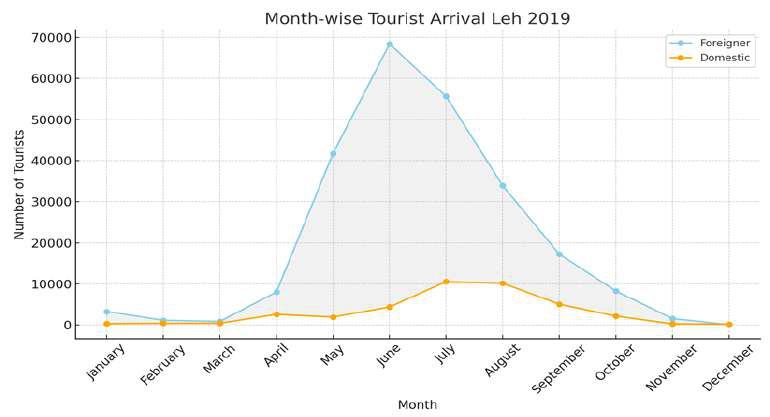
Source: Tourism Department, Leh
Tourism Activities:
- Bike Tours: Popular among adventure tourists, bike tours attract a significant number of visitors during the peak season (Dhawan, 2020).
- Monastery Tours: These cultural tours are a major draw for tourists interested in Ladakh’s heritage (Chaudhary, 2019).
- Trekking: Ladakh’s rugged terrain offers numerous trekking routes that are popular with adventure enthusiasts (Wani & Kumar, 2020).
Youth Entrepreneurship
Many local youths are employed on a daily wage basis, often working as marshals, mechanics, or guides for companies from other regions (Sangra, 2021). Tourism-Related Ventures: Opportunities include small-scale tour operations, souvenir shops, and local eateries (Zhang & Zhang, 2018).
Youth entrepreneurship, particularly in tourism-dependent regions like Ladakh, faces both significant opportunities and considerable challenges. The entrepreneurial landscape is marked by a mix of self-employment, seasonal work, and business ventures in the tourism sector.
Many local youths engage in self-employment, often in the form of small-scale ventures related to tourism, such as local handicrafts, tour guiding, and small shops (Beine, 2019). Similar to tourism employment, youth entrepreneurship in Ladakh is also influenced by seasonal variations, affecting the viability and sustainability of small businesses (Schröder & Ratten, 2020).
Entrepreneurs often face skill gaps in business management, marketing, and financial literacy (Raj, 2019). Access to training programs, financial support, and mentorship is critical for fostering successful youth-led ventures (Sharma, 2020) but is not always available.
Survey of Youth in Tourism Sector
The following tables provide insights into the demographic details of the survey participants and their distribution by category.
Table 2: Demographic Details of Sample
| Demographic Factor | Details |
|---|---|
| Total Sample Size | 50 participants |
| Age Range | 18-50 years |
| Gender Distribution | Male and Female participants |
| Educational Background | 8th Standard to College Graduates |
Table 3: Sample Distribution by Category
| Category | Number of Participants | Percentage of Total Sample |
|---|---|---|
| Youths in Tourism Activities | 20 | 40% |
| Homestay Owners | 10 | 20% |
| Small Business Owners | 15 | 30% |
| Self-Help Groups (SHGs) | 5 | 10% |
Table 4: Types of Employment, Daily Wages, and Businesses
| Business Type | Description | Earnings (INR) |
|---|---|---|
| Marshalls | Guide tours, especially for motorcycle and adventure tours, working with agencies. | ~1,000 (Per Day During Season) |
| Backup Guys | Operate pickup vans for transportation, including vehicle and mechanic costs. | ~4,000 (Per Day During Season) |
| Tours and Travel Agency Owners | Operate guided motorcycle and adventure tours during peak summer season. | 3,00,000 – 7,00,000 Per Season |
| Small Shops | Sell local handicrafts, souvenirs, and food items to tourists. | 2,000 – 3,500 Sales Per Day During Season |
| Self-Help Groups (SHGs) | Produce and sell traditional goods and services cooperatively. | Varies by group |

Findings
- Income and Employment Conditions: Out of the 20 youths, 15 (75%) working as marshalls or backup operators manage their own pickup vans, which they purchased through EMIs. These individuals earn ₹3,500 – ₹4,000 per day during the peak season, which covers their costs for themselves, vehicle, diesel, and maintenance. For marshalls who do not have their pickup vehicles, they earn a salary of around ₹10,000 per month if employed full-time or ₹1,000 per day if just deployed with a group as a gig worker. They do not receive insurance or incentives from the agencies they work with. Additionally, these youths are employed only for about 20 days during the peak season.
- Interest in Self-Employment / Entrepreneurship: Among the 20 youths involved in tourism activities, 16 (80%) engage in parallel work by building connections with tourists while working with agencies. They often refer tourists directly to their own services, bypassing agency commissions. However, most lack structured lead generation or customer acquisition systems; only 4 (20%) actively use social media platforms like Instagram to promote their services.
- Limited Professional Development: Only 2 out of 20 (10%) youths have undergone formal training or certification in tourism or related fields, indicating a widespread lack of professional development resources.
- Defense Sector Dependency: 12 (60%) of the youths also work part-time as contractors for defense organizations during the off-season to supply army supplies to the higher altitudes like Siachen. This is their primary source of income during the winter months when tourism activity is minimal.
Profile: Tenzin, a 25-year-old local from Ladakh, has been working as a marshall with a renowned Ladakhi agency and makes around 10,000 per month during the peak tourism season. Driven by a passion for the region and its tourism potential, he has also embarked on his entrepreneurial journey by starting his own travel agency, named Ladakh Dreamers.Business Activities: Tenzin operates his agency by leveraging resources from a local bike rental service. He rents bikes and gear for his tours, which he organizes independently. To generate leads, Tenzin taps into his network from previous travel groups and has recently started using an Instagram channel to promote his trips.Performance and Financials: In the current tourism season (May 2024 to July 30, 2024), Tenzin has conducted four tours, each lasting ten days. His leads came from various sources: two from previous travel groups, one from his new Instagram channel, and one from the bike rental agency. Despite the
challenges, Tenzin has managed to earn a profit of approximately ₹1 lakh from these tours after covering all costs.Challenges and Aspirations: Tenzin is keen on expanding his agency and operating independently. However, he recognizes gaps in his skill set, particularly in attracting leads through social media. His interactions with tourists have revealed that a significant number are influenced by social media content, especially Instagram reels. This insight underscores his need for a better grasp of digital marketing techniques.Future Goals: To enhance his business operations, Tenzin aims to enroll in a certificate course specializing in winter trekking. He also plans to obtain the necessary permits to conduct these expeditions, ensuring he can offer diverse and legally compliant tour experiences.Support Needs: Tenzin would benefit from targeted training in digital marketing to effectively harness social media for lead generation. Additionally, guidance on navigating the permit process and enhancing his business acumen in winter trekking would be crucial for his agency’s growth and success.Summary: Tenzin’s journey illustrates the potential for local youths to thrive in Ladakh’s tourism sector. His entrepreneurial spirit, combined with a clear understanding of market trends, positions him well for future growth. Addressing his skill gaps and providing support for permit acquisition and specialized training could significantly enhance his business prospects and contribute to the region’s tourism development.
1. Homestay Owners
Dependence on Agencies: Of the 10 homestay owners interviewed, 8 (80%) rely heavily on agencies to bring customers, with very few independent bookings. When clients extend their stay or book directly, homestays pay a commission of ₹500 – ₹1,000 to the agency. Occupancy rates are low due to a preference among large tour operators for hotels or lodges that can accommodate bigger groups.
Challenges in Direct Marketing: Homestay owners struggle with direct outreach to small groups and independent travelers, impacting their profitability and sustainability. 7 out of 10 (70%) homestays are even not listed on major travel platforms or lack an active online presence, which limits their exposure to potential tourists and affects their booking rates. The lengthy process and low amount of government subsidies for developing homestays deter owners from investing further.
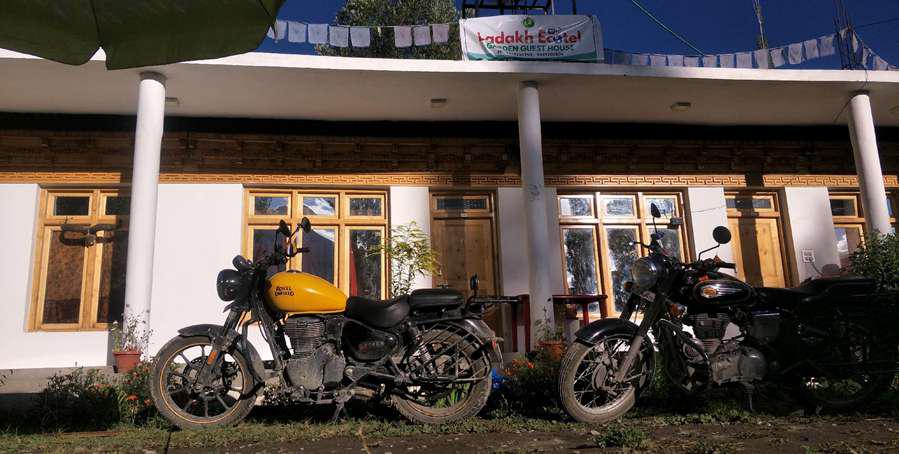
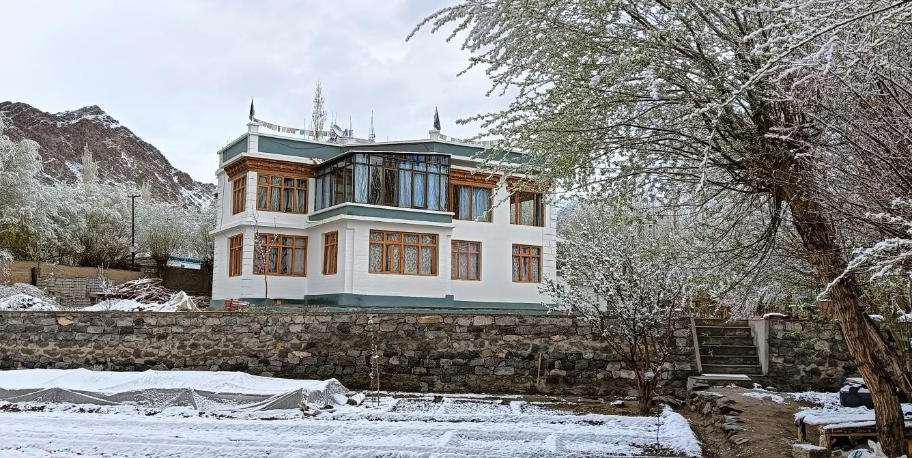
The Story of Dorje and Ladakh EcotelProfile and Background: Dorje, a retired military officer with a 25-year career in the Artillery Division, embarked on a new chapter by founding Ladakh Ecotel in Diskit, Nubra Valley in 2018. Transitioning from a distinguished military career to hospitality, Dorje initially started with 4 rooms and has expanded to 8 rooms to accommodate a growing number of guests.
Business Operations: Ladakh Ecotel charges ₹3,000 per room per day for direct bookings, while the rate for agency bookings is ₹2,500, inclusive of food. The homestay offers high-quality rooms and meals prepared with organic produce from their kitchen garden. Dorje and his wife personally manage
the kitchen, ensuring that guests enjoy fresh and nutritious meals.
Challenges and Customer Base: Dorje’s homestay primarily attracts guests through small, local agencies operated by Ladakhi youths. Despite maintaining high standards and providing personal service, Ladakh Ecotel struggles with visibility due to the lack of an online presence. The homestay is not listed on travel platforms or actively promoted on social media, which limits its reach.
Occupancy and Seasonal Trends: During the peak season, Ladakh Ecotel manages an occupancy rate of around 5 rooms per day for approximately 20 days. In contrast, during the off-season and winter months, the occupancy rate drops to 2-5 rooms total for the entire month. Full occupancy is rare, reflecting the seasonal nature of tourist traffic in Ladakh.
Staffing and Operations: The homestay employs two staff members from Bihar who handle property maintenance and room service. Dorje and his wife oversee the kitchen operations, preparing meals from their garden produce, which enhances the guest experience.
Future Plans: Dorje plans to enhance the appeal of Ladakh Ecotel by introducing a stargazing experience with a small telescope, leveraging the Nubra Valley’s natural beauty. He also intends to create a small showcase of military tools, machinery, and artillery from his service years. This display is
expected to attract visitors interested in military history and provide a unique point of interest. Dorje believes that the exhibition will generate word-of-mouth marketing from visitors and increase the homestay’s appeal.
Additionally, Dorje aims to improve visibility by listing Ladakh Ecotel on online travel platforms and developing an Instagram presence. These efforts are designed to boost direct bookings and improve year-round occupancy rates.
Summary: Ladakh Ecotel, under Dorje’s management, offers a distinctive lodging experience in Nubra Valley, combining high-quality service with unique features. Despite current challenges with visibility and seasonal fluctuations, Dorje’s plans to introduce stargazing and a military showcase, along with enhanced marketing efforts, hold promise for increasing the homestay’s attractiveness and occupancy throughout the year.
2. Small Shop Owners and Eateries
Seasonal Dependency and Income Fluctuations: Out of the 15 small business owners interviewed, 10 (67%) rely primarily on tourism for their income. During the off-season, many of these shops close or depend on agricultural produce for sustenance. Small eateries, especially those located at tourist hotspots like monasteries, Khardungla, and along bike routes, face similar issues, often closing or operating at minimal capacity during winter months due to a sharp decline in tourist traffic. The average occupancy for these eateries and shops during the off-season is minimal, with some businesses only seeing 2-5 room or shop occupancies throughout the entire month.
Challenges with Local Products: Small shop owners report that traditional Ladakhi products, such as yarn and brass items, have low sales. The primary issue is their high price compared to more affordable souvenirs and fridge magnets. For example, while local crafts might be priced significantly higher, tourists often opt for cheaper items. This pricing challenge is compounded by a lack of marketing support, which limits the visibility and appeal of these traditional products.
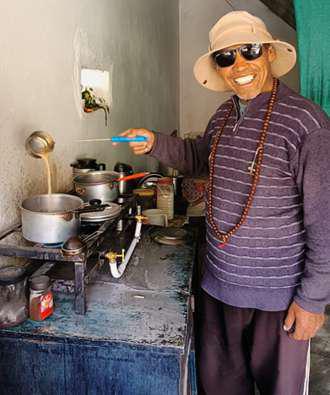 Tsering’s Tea Shop
Tsering’s Tea ShopProfile: Tsering, a 40-year-old local entrepreneur, operates a small tea shop located just opposite the Mulbekh Monastery, which is dedicated to the future Buddha. The monastery is situated approximately 30 km from Kargil.Business Operations: Tsering’s tea shop offers a variety of beverages, including traditional butter tea, tea, maggie noodles, and Kahwa. Despite the strategic location near a prominent monastery, Tsering faces challenges with attracting tourists. The proximity of Kargil, a larger town, means that many tourists do not stop at his shop. Additionally, visitors to the monastery often do not purchase from him.Seasonal Sales and Sustainability: During the peak tourist season, Tsering’s sales range between INR 500 to 700 per day. However, in the winter months, he closes the shop due to a significant drop in tourist traffic. To sustain his family throughout the year, Tsering manages a 2-hectare agricultural land where he grows wheat and barley.Future Plans: Tsering is contemplating diversifying his activities but is uncertain about what new ventures to pursue. He seeks opportunities to enhance his business operations or explore alternative income sources to support his family during the off-season.
Self-Help Groups (SHGs)
Lack of Market Integration: The 5 SHG members reported that there are limited outlets (in many cases, just one, where each of the member gets one day for selling their produce) promoting their products to tourists. While some small startups help market SHG products, there is no comprehensive infrastructure supported by the government to facilitate this. The reach of existing outlets is insufficient to boost the visibility of SHG products among tourists.
Training and Awareness: The members noted a lack of access to specialized training programs and awareness about government schemes for winter trekking and other tourism activities. This limits their ability to effectively participate in and benefit from the tourism sector.
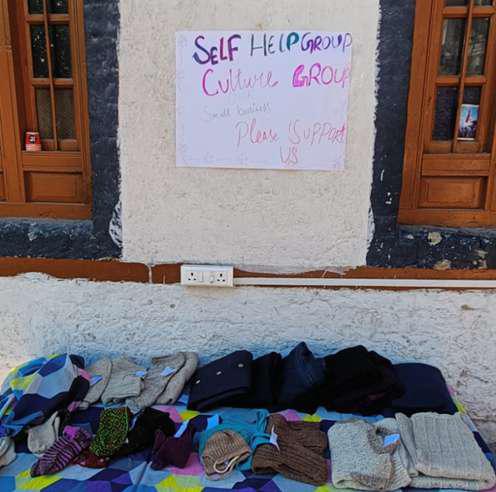
Dolma Aunty’s Handicraft SHGProfile: Dolma Aunty, a 50-year-old member of a local Self-Help Group (SHG), specializes in selling hand- woven gloves, socks, shawls, and sweaters. Her SHG, based in Mulbekh, consists of 7 members who each take turns selling their products outside the Mulbekh Monastery.
Business Operations: Dolma Aunty and her SHG members sell their handcrafted products on a small bench outside the monastery. Each member is allocated one day to showcase and sell their items. The group has not received any government funding or marketing support, limiting their visibility and reach.
Sales and Sustainability: Dolma Aunty makes monthly sales of around INR 5,000 from her handicrafts. Her two sons are involved in tourism activities, which provide additional family income. The SHG operates with women aged between 25 and 55, and the average monthly sales for each member range from INR 5,000 to 7,000.
Challenges and Support: The SHG faces several challenges, including a lack of training in sales, branding, and marketing. There is no branding for the SHG or promotional support from external sources, affecting their ability to attract more customers and grow their business. Dolma Aunty is keen on improving their sales strategy but lacks resources and knowledge to do so effectively.
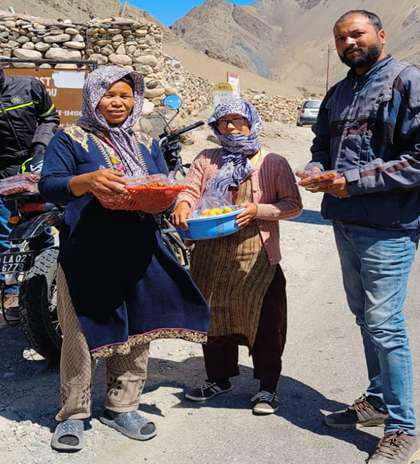
harvest these fruits from their home orchards and market them primarily to bikers stopping at permit check posts.Business Operations: The group gathers their harvested fruits and sells them together. They target bikers who pass through the area, offering boxes of apricots and other fruits at INR 100 per box. During peak tourist season, the group generates sales of around INR 1,000 to 1,500 per day. However, business comes to a halt during the winter months when tourism significantly drops.Sales and Sustainability: The group’s sales strategy focuses on direct interactions with bikers, leveraging the high traffic at check posts. Despite this, they face challenges in sustaining income throughout the off-season. The group is exploring ways to produce apricot-based products to utilize excess produce and reduce waste.Challenges and Support: The community group lacks knowledge and support for creating and marketing apricot-based products. They are eager to explore new opportunities but have no access to training or resources to develop these products. Without external support or guidance, they struggle to diversify their product range and ensure a steady income year-round.
Challenges faced by local youths in Ladakh’s tourism sector
Seasonal Employment and Unemployment: Tourism in Ladakh is predominantly active from May to September. Outside this peak season, employment opportunities diminish, leading to significant financial instability for many individuals. Even those with higher education, including graduates and technical diploma holders, frequently find themselves in seasonal and low-paying jobs such as marshalls.
Outsider Dominance: The tourism sector is largely controlled by agencies based outside Ladakh, with major operations in cities like Delhi, Bangalore, Pune, and Mumbai. Local youths typically work on a daily wage basis with these external operators, receiving minimal financial benefits. These agencies often focus on their own interests, limiting tourists’ exposure to local culture and crafts.
Cultural Exclusion: The dominance of external agencies leads to a diminished representation of authentic Ladakhi culture in tourism experiences. This results in local businesses struggling to integrate cultural elements into the tourism sector, leading to underutilization of Ladakhi cultural assets.
Winter Challenges: During winter months, key tourist routes such as the Manali-Leh and Srinagar-Leh highways are closed due to heavy snowfall. Air travel remains the only viable access to Leh, significantly restricting winter tourism and income opportunities for local guides and tour operators.
Perceptions of Employment Dignity: Certain roles in the tourism sector, such as positions in restaurants or homestays, are viewed as low-status jobs by local youths. This perception leads to these positions being filled by workers from other states, contributing to a diminished sense of dignity associated with local employment opportunities.
Absence of Ecosystem for Youth Agencies: There is a lack of ecosystem support to develop youth-led agencies or assist them in starting their own businesses, which further impedes entrepreneurial growth. Lack of Entrepreneurial Knowledge: Many local youths lack essential entrepreneurial skills and business management knowledge, which hinders their ability to start, manage, and promote their own businesses effectively.
Training and Skill Development: There is a critical need for enhanced training in business management, digital marketing, and customer service. The current deficit in training affects the competitiveness of local businesses within the tourism sector.
Lack of Skill Development Program Awareness: Awareness and reach of existing skill development programs are limited, reducing their effectiveness in preparing local youths for entrepreneurship in the tourism sector.
Marketing and Promotion Issues: Local businesses and self-help groups (SHGs) face significant challenges in marketing their products and services. The absence of effective promotional strategies and collaboration within the community exacerbates this issue.

Underutilization of Local Produce: Ladakh’s rich organic produce, including apples, apricots, and cherries, is not effectively marketed to tourists. Local businesses have not fully leveraged these resources, missing out on potential revenue from agritourism.
Fragmented Efforts: There is a lack of effective collaboration within the local community to promote and sell local cultural products. Unlike other regions where travel agencies partner with craft stores, Ladakh’s local businesses have not developed such networks, limiting their ability to showcase and sell local crafts, foods, and products to tourists.
Dependency on Defense Jobs: Many locals resort to temporary jobs with defense organizations during the off-season, which often do not align with their long-term career aspirations. This dependency on defense-related employment limits their opportunities for growth within the local tourism sector.
Opportunities in Ladakh’s tourism sector for youth
Ladakh’s tourism sector is burgeoning, and several opportunities are emerging for local youths to capitalize on. These opportunities are bolstered by recent trends and supportive infrastructure.
1. Existing Opportunities
- Adventure Tourism
- Current Trends: Adventure tourism, including trekking, biking, and mountaineering, made up 40% of tourism activities in Ladakh in 2023. The sector saw a 25% increase in visitors from 2022 to 2023, with a projected CAGR of 15.4% from 2022 to 2027.
- Cultural and Eco-Tourism
- Current Trends: Cultural tourism increased by 30% in visitors to cultural sites in 2023. Eco-tourism is growing at a rate of 20% annually.
- Opportunity: Developing ventures focused on cultural and eco-tourism can attract tourists seeking unique experiences and sustainable travel.
- Local Produce and Crafts Marketing
- Current Trends: The market for Ladakh’s organic produce, including apples, apricots, and cherries, is valued at approximately ₹50 crore annually.
- Opportunity: Establishing businesses to promote and sell local organic produce and traditional crafts to tourists.
- Community-Based Tourism
- Current Trends: Community-based tourism initiatives have increased local benefits by 15% in similar regions.
- Opportunity: Initiatives like community-managed homestays and cultural tours provide economic benefits and preserve cultural heritage.
- Technology Integration
- Current Trends: Online bookings accounted for 60% of all travel arrangements in 2023.
- Opportunity: Implementing technology, such as digital marketing and online booking systems, can streamline operations and reach a broader audience
- Expanding Market Reach
- Current Trends: International tourist arrivals to Ladakh increased by 18% in 2023
- Opportunity: Expanding business offerings to cater to international tourists and diverse market
segments.
Recommendations
To address the challenges faced by youth in Ladakh’s tourism sector and capitalize on available opportunities, a multi-faceted approach is required. Here are targeted recommendations for various stakeholders:
- Leverage Vocational Training
- Enroll in the Ladakh Skill Development Mission’s programs focused on traditional crafts, tourism management, and small business operations.
- Utilize National Skill Development Corporation (NSDC) courses in customer service, tour guiding, and hospitality management to build a robust skill set.
- Develop Niche Tourism Ventures
- Focus on adventure tourism and eco-tourism by creating unique experiences like guided snow treks or eco-friendly lodgings.
- Incorporate cultural elements into tour packages to attract tourists seeking authentic Ladakhi experiences.
- Promote Local Produce and Crafts
- Start ventures to market Ladakh’s organic produce and traditional crafts through local markets and online platforms.
- Use the Promotion of Handicrafts and Handlooms scheme for financial support and marketing assistance.
- Form Collaborative Networks
- Collaborate with other local entrepreneurs to form cooperatives or networks for shared marketing and resources.
- Participate in local business forums and tourism associations to build connections and gain market insights.
- Adopt Technology
- Implement digital marketing strategies and online booking systems to streamline operations and reach a wider audience.
- Develop mobile applications or websites for bookings and to provide information about local tours and services.
- NGOs to Facilitate Capacity Building
- Offer workshops and training sessions on entrepreneurship, business management, and digital marketing.
- Partner with local businesses to provide practical training in tourism operations and customer service.
- Enhance Market Access
- Develop platforms or marketplaces for local artisans and producers to sell their goods online, such as e-commerce sites or craft fairs.
- Organize trade shows and exhibitions to showcase Ladakhi products and attract buyers.
- Support Community-Based Tourism
- Assist in setting up community-managed homestays and cultural tours. Provide training on hospitality management and customer relations.
- Facilitate the development of community-based tourism initiatives that empower local communities and preserve cultural heritage.
- Raise Awareness
- Conduct outreach programs to inform local youths about existing skill development programs and financial assistance opportunities.
- Develop informational materials and host community meetings to discuss available resources and support systems.
For Local Administration
- Expand Funding and Mentorship
- Increase the budget and scope of the Ladakh Startup Support Scheme, providing up to ₹10 lakhs in seed funding and mentorship.
- Create additional mentorship programs to guide local entrepreneurs through the business development process.
- Enhance Skill Development Reach
- Expand vocational training programs to include advanced courses in business management and digital tools.
- Partner with educational institutions and industry experts to offer specialized training and diploma courses for the tourism sector.
- Invest in Winter Tourism
- Allocate up to ₹20 crore for developing winter tourism infrastructure, including snow trekking routes and winter festivals.
- Promote winter tourism through targeted campaigns and partnerships with travel agencies.
- Improve Job Perceptions
- Launch awareness campaigns to highlight the value and benefits of various tourism roles, including homestays and local guide positions.
- Facilitate job fairs and recruitment drives to connect local youths with tourism-related employment opportunities.
- Ensure income security and expedition insurance for Ladakhi guides.
- Increase Awareness of Government Schemes
- Implement targeted outreach programs to increase awareness of government schemes and funding opportunities among local youths.
- Use local media, community events, and information centers to disseminate details about available schemes and application processes.
- Develop New Tourism Sites
- Explore Umba La and Lalung La in Kargil district as summer skiing sites.
- Identify and map new ski slopes in Kargil, Drass, and Zanskar ranges.
- Plan and promote international-level ice climbing and skiing events through tourism department channels.
- Promote Wellness Tourism
- Set up yoga retreats in rural areas in collaboration with local communities.
- Brand Ladakh as a “Rejuvenation” destination for expats and corporates: clean air, yoga, organic cuisine, spiritual journey.
- Enhance Homestays
- Promote homestays near iconic tourist spots, monasteries, and heritage sites.
- Convert homestays to Astro stays by installing telescopes and providing technical training to homeowners, especially in Nubra Valley, Hanley, and Hunder zones.
- Organize village-level hospitality training camps covering culinary training, housekeeping, first aid, and behavior training for guest interaction.
- Create a portal to list, manage, and provide booking facilities for all these homestays.
At the Policy Level
- Increase Financial Support
- Expand and enhance subsidies and grants under the Ladakh Startup Support Scheme and other relevant programs to cover a broader range of business needs and sectors.
- Introduce targeted financial products, such as low-interest loans and venture capital, to support tourism-related startups and expansions.
- Develop Comprehensive Tourism Strategies
- Implement the Ladakh Tourism Development Plan 2022-2027 with a focus on sustainable growth, infrastructure development, and promotion of local culture and crafts.
- Ensure the integration of tourism strategies with broader economic and social development plans.
- Foster Public-Private Partnerships
- Encourage collaboration between government bodies, private enterprises, and NGOs to pool resources, share expertise, and develop tourism infrastructure and programs.
- Create incentive programs for private sector investment in tourism projects and local businesses.
- Improve Access to Capital
- Develop and promote government-backed loan schemes with favorable terms for tourism businesses, including extended repayment periods and lower interest rates.
- Increase funding for tourism infrastructure projects and support the establishment of financial institutions that cater specifically to local entrepreneurs in the tourism sector.
- Enhance Awareness Programs
- Launch comprehensive awareness campaigns to inform local youths about the various government schemes and funding opportunities.
- Utilize local media, community centers, and outreach programs to increase visibility and accessibility of these initiatives.
Conclusion
The research on youth employment and entrepreneurship in Ladakh’s tourism sector reveals critical insights:
The research highlights several key aspects of youth employment and entrepreneurship within Ladakh’s tourism sector, elucidating both challenges and opportunities
1. Seasonal Employment and Economic Instability
The tourism sector’s heavy reliance on a short peak season from May to September creates significant employment gaps during the off-season. This results in many local youths either migrating for work or taking up low-paying, temporary jobs with defence operations. To address this, it is essential to diversify tourism offerings and develop winter tourism infrastructure to provide stable employment throughout the year.
2. Barriers to Entrepreneurship
Local youths encounter substantial barriers to entrepreneurship, including limited business knowledge, financial constraints, and inadequate training. The predominance of external agencies in the tourism sector restricts locals to lower-income roles. Implementing targeted training programs, expanding financial support through schemes like the Ladakh Startup Support Scheme, and increasing mentorship opportunities can empower local youths to start and sustain their own businesses.
3. Infrastructure and Accessibility Challenges
Seasonal snow closures and limited year-round accessibility hinder the growth potential of tourism-related businesses. Current infrastructure projects such as the Zojila Pass Tunnel and the Leh-Manali Highway Upgradation are critical for improving connectivity. These developments, along with increased investment in winter tourism infrastructure, will facilitate year-round tourism activities and business continuity.
4. Cultural Integration and Market Linkages
The underutilization of local cultural assets and products within the tourism sector presents a missed opportunity for economic growth. Promoting Ladakhi handicrafts, organic produce, and cultural experiences through enhanced marketing and community-based tourism initiatives can better integrate local culture into the tourism experience. Establishing effective market linkages and collaborative networks will also strengthen the promotion and sale of local products.
5. Educational Mismatch and Skill Development
There is a mismatch between the educational qualifications of local youths and the available job opportunities, with many holding technical degrees but working in low-skill roles. Better alignment of educational programs with local industry needs, coupled with comprehensive training in business management and digital skills, will improve job prospects and entrepreneurial success.
6. Agricultural Engagement and Tourism Potential
While many youths engage in agriculture during the off-season, the potential for agricultural tourism and value-added products remains untapped. Developing agri-tourism ventures and integrating local produce into tourism offerings can create additional revenue streams and enhance the local economy.
7. External Influence and Local Control
The tourism sector’s control by external agencies limits local economic benefits and the ability to showcase Ladakhi culture. Expanding local training programs, advocating for increased local involvement in specialized tours, and fostering public-private partnerships will enhance local control and ensure a more equitable distribution of tourism revenue. Addressing these challenges through targeted policies, training programs, financial support, and strategic community engagement will significantly enhance youth employment and entrepreneurial opportunities in Ladakh’s tourism sector. This approach will foster sustainable economic development and ensure that the benefits of tourism are more equitably shared within the local community.


